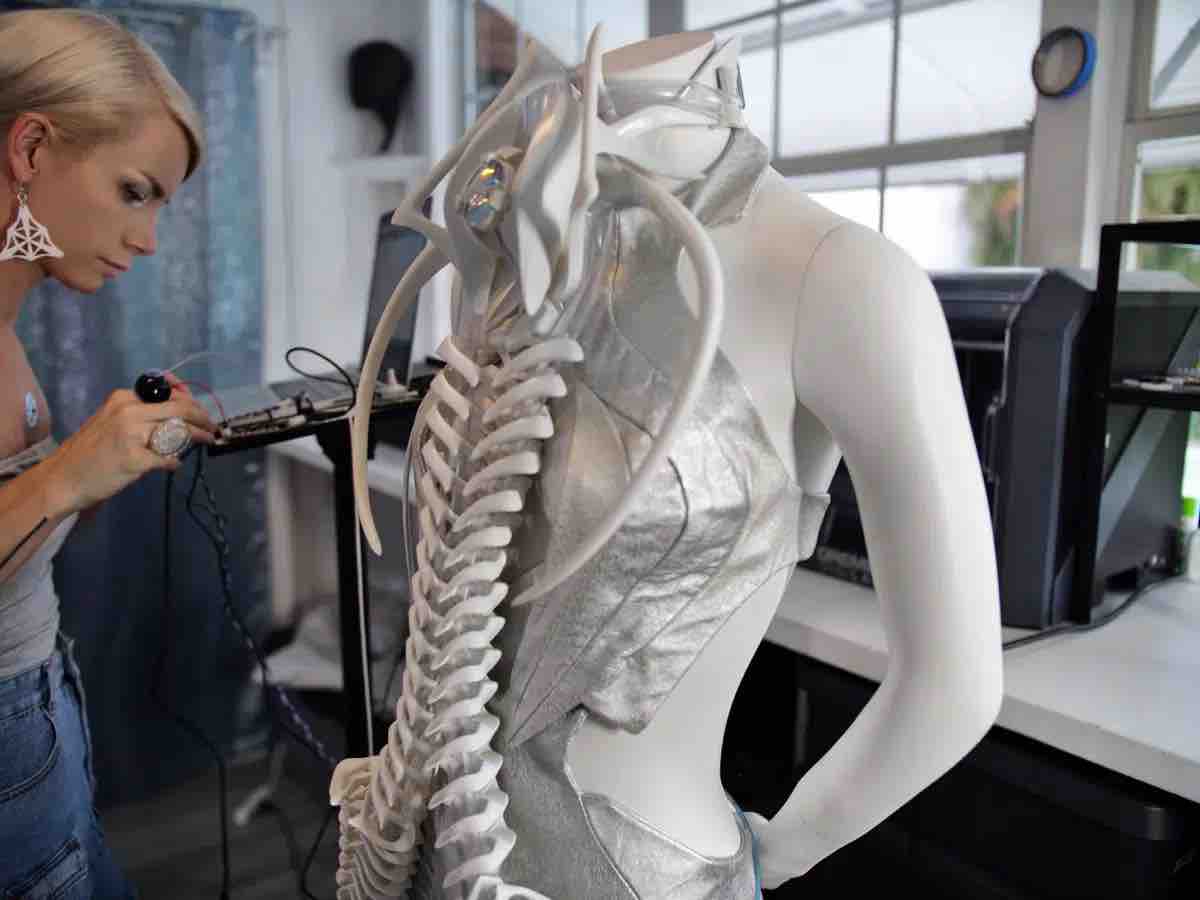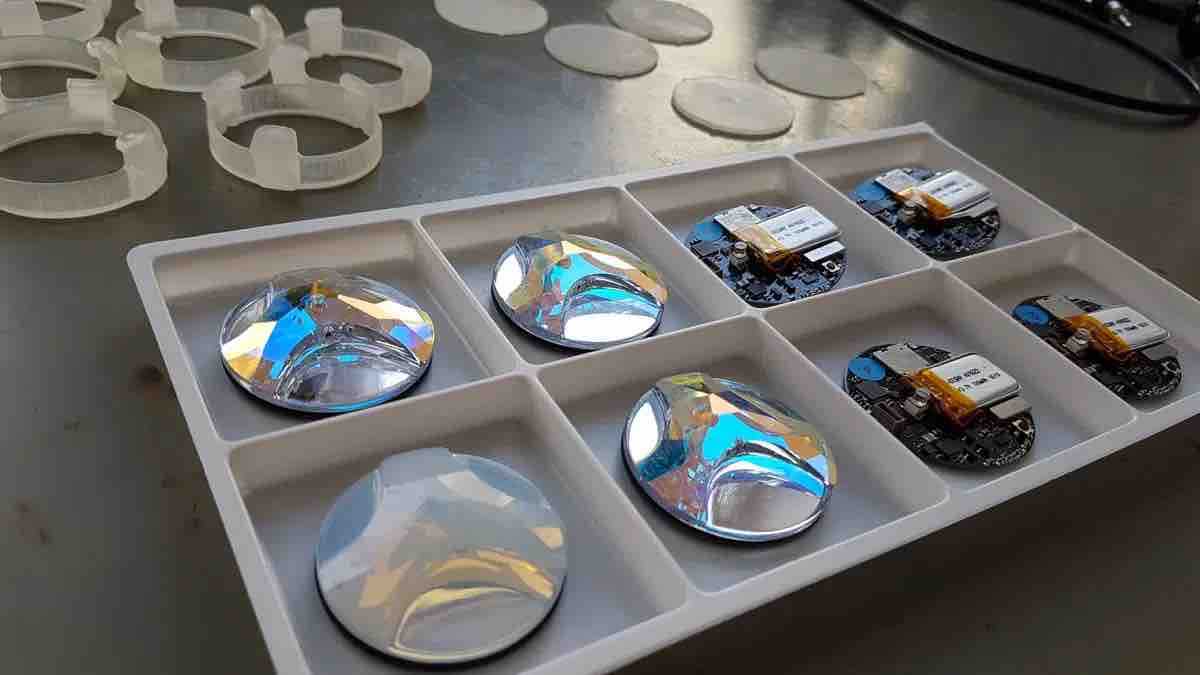
Sensors. Synergy. Emotions on display.
Blending design and engineering in her work, Anouk Wipprecht continues to reign in the world of interactive, focusing on the intersection of fashion and technology–or ‘fashion tech,’ as she refers to the futuristic genre. Innovating and 3D printing on all cylinders, her work is captivating merely on the first glance; however, there are numerous layers to examine in her latest work: The HeartBeatDress.
Expanding sensory awareness through fashion and technology, Wipprecht has a message for the modern wardrobe, bidding farewell to the typical, and accelerating far beyond the basic tools.
Expanding Design via Electronics and 3D Printing
Wipprecht was delving into design as early as 14 years old. By the time she entered fashion design school, she was eager to offer more experimental impact in making wearable pieces–seeking out lights, sensors, and complex mechanics.
“That’s when most of my designs started being fully animatronic and technical,” said Wipprecht.
Soon, she was creating 3D printed fashion and forging partnerships that have continued to grow over the years. This includes Shapeways, manufacturing 3D printed prototypes and end-use parts for multiple projects. Wipprecht points out that the relationship has been successful and enduring not only due to high-quality, high-performance designs and parts, but also because together they always run on time.

3D Printing in Fashion Requires Strategy and Compromise
The Amsterdam-born designer sets a tight schedule for many of her 3D printed fashion-tech projects, driven by customer, partner, or internal deadlines. Components like those included for the HeartBeatDress tend to be unique and complex in structure. Predecessors like the Smoke Dress, cloaking the wearer in smoke to protect them, or the Spider Dress, offering an attack mechanism should any foe approach, were certainly not your average fashion designs either.
“The key is to figure out how you can make the design aesthetically pleasing, without compromising the ability to walk, sit, and be comfortable overall,” said Wipprecht. “You have to account for movement, posture, and where on the body to place the 3D printed parts. For example, the shoulders are quite interesting on the Spider Dress, and the Proximity Dress has hip parts.”
Italian architect and professor, Niccolo Casas, has also worked on this series of fashion-tech projects for over a decade, assisting Wipprecht in building pieces of work that not only continue to push boundaries, but feature different complexities like interlocking parts for the application of 3D printing technology in the fashion industry.
For the HeartBeatDress, Shapeways, Casas, and Swarovski all collaborated in creating an intense design to mimic the human spine surrounding the heart. Swarovski, further embracing Wipprecht in a novel program centered around experimental work, created the touch sensor, placing film over one of their crystals and allowing the piece to be fitted with a flat PCB and conductive coating. Eventually, ten units were created.
The HeartBeatDress displays the general mood or feelings of the wearer, flashing in time with the heart rate. This innovative detail resulted from Wipprecht’s previous experience working with Swarovski and researching how crystals and the heart may affect one another.

Advanced 3D Printing Materials and Technology for Prototyping and End-Use Parts
Shapeways 3D printed the hip pieces for the dress, using Nylon 11 [PA11 (SLS)] and Selective Laser Sintering. Although the fashion-tech designer is no stranger to prototyping on her own, she relies on Shapeways for the product development process and manufacturing of the end product. SLS 3D printing is a favorite of Wipprecht as she recognizes the freedom afforded to designers, architects, and engineers. This begins with the ability to eliminate the complications surrounding design requirements for supports. She points out that she has seen the best results with SLS 3D printing and lightweight material like Nylon 11 [PA11 (SLS)], also providing the durability and flexibility necessary to her designs.
Additional technology included the BIOPAC MP40 system, used to translate heart rate data, along with the PACIS pak, a wearable device responsible for biosensing.
With over 60 projects in her vast portfolio, Wipprecht’s career includes numerous combinations of fashion and technology, supported by unique designs. Despite her many accomplishments, she still has a clear vision for what’s next, and a long list of projects she wants to bring to life. This includes encouraging as many young scientists, designers, and engineers as possible, and eventually offering designs like the HeartBeatDress as open source.

About Shapeways
Enjoy the benefits of this advanced technology and a wide range of materials from Shapeways for 3D printing your creations with accuracy, complex detail, and no minimum or limits in terms of mass customization or single part orders. Shapeways has worked with over 1 million customers in 160 countries to 3D print over 21 million parts! Read about case studies, find out more about Shapeways additive manufacturing solutions, and get instant quotes here.


